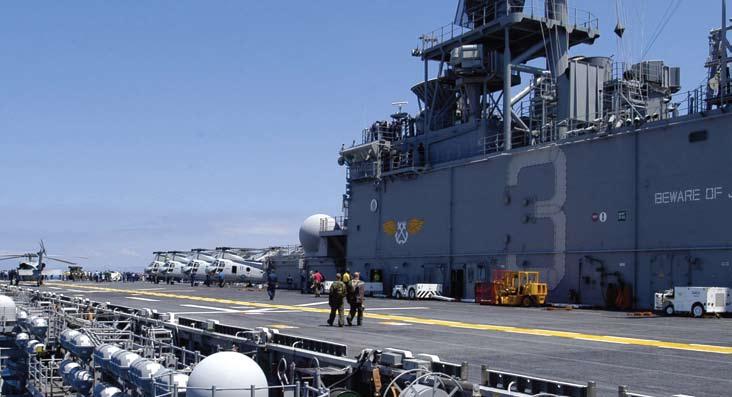
3 minute read
Support Equipment Gone Wild
from MECH Fall 2008
Navy photo by MC1 Robert Keilman
Advertisement
By AS3 Christopher Hawley
After a successful and relaxing port of call in Malta, the first of three in the Mediterranean, our ship made her way back into deep water. Flight ops were scheduled to begin later that morning, and it was my task to get the support equipment back where it belonged, before the first launch of the day. Having done this thousands of times, I thought, “What can go wrong?”
Support equipment had been moved from the hangar bay and was parked behind the island, in the bomb farm, to make room for a reception the ship had hosted while in port. I walked behind the island to survey the equipment and to formulate a plan. Two A/ S37A-3 shipboard mobile electric power plants (MEPPs) were parked side-by-side and needed to be moved one at a time. I should have moved the T-5 Jenny behind the outboard MEPP, but decided not to make any more moves than necessary to get the job done. There was a clear path behind the inboard MEPP, so I moved that one first.
I completed the pre-op inspection, using NA 19-600-300-6-1, and removed the tie-down chains and wheel chocks. Since the equipment was near an AH-1 helicopter, I had two yellowshirt safety observers assist me. I squeezed between the two MEPPs, sat in the operator’s compartment, and turned the wheels to the right to have a little more clearance between both units. After starting the unit and achieving a stable idle speed,
I flipped the switch to propulsion. My foot held the service brake, as I slid the gear selector to reverse and removed my foot from the brake pedal. The MEPP lurched backward.
My mind moved at warp speed, as I pondered the situation. I hadn’t even touched the foot-control pedal. “Why was this thing moving?” I wondered. Before I could react, the MEPP hit the island, then an X20J box cover and a scupper drain line. Fortunately, the safety observers were far enough away, so they didn’t get run over. After the MEPP stopped, I reached down and manually lifted the foot-control pedal, placed the gear selector in neutral, and turned off the engine. I tried to figure out why this unit had taken off like it was possessed.
After I caught my breath, I surveyed the damage to the island. The MEPP also had been dented and scratched, and the cable-storage compartment had been pushed out of alignment. I humbly walked to my division and told my chief what just had happened. The safety department and quality-assurance division immediately investigated the mishap.
They determined that the cause was right there in the engine compartment. The hydraulically propelled unit has a cable running from the foot-control pedal to an inching valve, which couples a servo to the swash plate and varies the displacement of the pump. The harder you press the foot control, the greater the flow of fluid from the pump to the drive axle. The foot-control cable had hung up in the full-open position.
Even though I had done a complete pre-op, according to the correct checklist, I didn’t catch this discrepancy. Checking for proper pedal movement and free operation is not one of the static checks. I learned that pre-op checklists are not always all-inclusive. Prior to operation, I now check all controls during my static inspection of self-propelled equipment. USS Keasarge

Navy photo by JOC Dave Nagle AIMD initiated an HMR/EI on the MEPP and TPDRs on the MRC and pre-op card.
Petty Officer Hawley works in AIMD IM4 Division onboard USS Kearsarge (LHD-3).
Analyst comment: Occasionally, we will find errors in publications. Operators and technicians need to identify and correct these problems. It seems like all the proper steps were made here. The key to success is to find these errors prior to an incident, and don’t get complacent.
Senior Chief Mark Tangney is the SE maintenance analyst at the Naval Safety Center.










